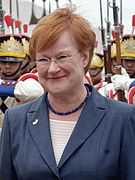
Martti Oiva Kalevi Ahtisaari is a Finnish politician, the tenth President of Finland (1994–2000), a Nobel Peace Prize laureate, and a United Nations diplomat and mediator noted for his international peace work.

The President of the Republic of Finland is the head of state of Finland. Under the Constitution of Finland, executive power is vested in the President and the Finnish Government, with the former possessing only residual powers. The President is directly elected by universal suffrage for a term of six years. Since 1991, no President may be elected for more than two consecutive terms. The President must be a Finnish citizen by birth. The Presidential office was established in the Constitution Act of 1919. Since March 1, 2012, the President of Finland has been Sauli Niinistö. In May 2017, Niinistö announced that he would seek re-election in the 2018 presidential election, running as an independent candidate. NCP and the Christian Democrat Party supported his candidacy. He won re-election in the first round on 28 January 2018 with 62.7% of the vote and his second term began on 1 February 2018.
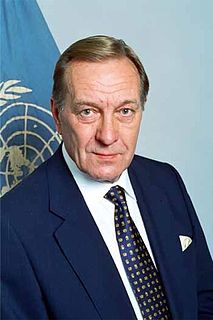
Harri Hermanni Holkeri was a Finnish statesman representing the National Coalition Party of Finland. He was the Prime Minister of Finland 1987–1991, speaker of the UN General Assembly 2000–2001 and headed the United Nations Interim Administration Mission in Kosovo from 2003- 2004.

Taisto Kalevi Sorsa was a Finnish politician who served as Prime Minister of Finland three times: 1972–1975, 1977–1979 and 1982–1987. At the time of his death he still held the record for most days of incumbency as prime minister. He was also a long-time leader of the Social Democratic Party of Finland.
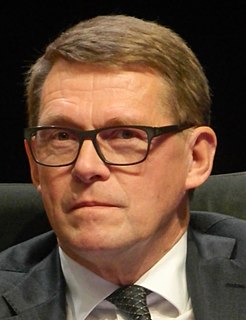
Matti Taneli Vanhanen is a Finnish politician who was Prime Minister of Finland from 2003 to 2010. He was also Chairman of the Centre Party, and in the second half of 2006 he was President of the European Council. In his earlier career he was a journalist. Vanhanen is the son of professor Tatu Vanhanen and Anni Tiihonen.
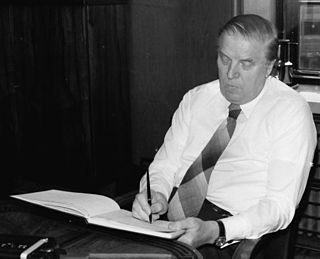
Johannes Virolainen was a Finnish politician and who served as 30th Prime Minister of Finland.
Suuret suomalaiset was a 2004 television show broadcast in Finland by Yle, which determined the 100 greatest Finns of all time according to the opinions of its viewers. The viewers were able to vote during a programme which lasted from October to December 2004. The show was a Finnish spin-off of the BBC's programme Great Britons.
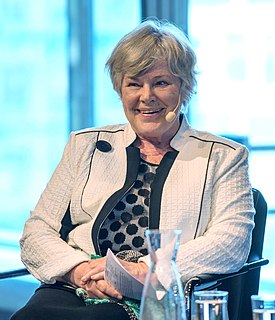
Märta Elisabeth Rehn is a former MP of the Swedish People's Party and the first female minister of defence in Finland and in Europe becoming the world's first woman defense minister. In the 1994 presidential election, she was narrowly defeated by Martti Ahtisaari.

A presidential election was held in Finland on 15 and 29 January 2006 which resulted in the re-election of Tarja Halonen as President of Finland for a second six-year term.
Arto Henrikki Lahti is a professor of entrepreneurship at the Helsinki School of Economics.

Johan Bjarne Kallis is the former chairman of the Christian Democratic Party (KD), previously known as the Finnish Christian Coalition (SKL), and a member of the Parliament of Finland. Kallis works as the principal of the Kokkola academy of commerce and has a Master's degree in political sciences.
The Finnish order of precedence is a nominal and symbolic hierarchy of important positions within the government of Finland. It has no legal standing, it does not reflect the Finnish presidential line of succession or the co-equal status of the branches of government under the constitution, and is only used to indicate ceremonial protocol.
- President of the Republic Sauli Niinistö
- Retired Presidents of the Republic in order of term:
- President Martti Ahtisaari
- President Tarja Halonen
- Speaker of the Parliament Paula Risikko
- Prime Minister Juha Sipilä
- President of the Supreme Court Timo Esko
- President of the Supreme Administrative Court Pekka Vihervuori
- Chief of Defence Jarmo Lindberg
- Chancellor of Justice Jaakko Jonkka
- Archbishop of Turku Tapio Luoma
- Chancellor of the Order of the Cross of Liberty Gustav Hägglund
- Chancellor of the Order of the White Rose of Finland and the Order of the Lion of Finland Aino Sallinen
- Chancellor of the University of Helsinki Thomas Wilhelmsson

Finnish-Mexican relations are diplomatic relations between Finland and Mexico. Both nations are members of the Organisation for Economic Co-operation and Development and the United Nations.
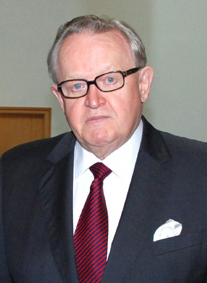
Presidential elections were held in Finland on 16 January 1994, with a second round on 6 February.

Presidential elections were held in Finland in January and February 2012. The first round took place on 22 January 2012 with advance voting between 11 and 17 January. Since no candidate received a majority of the vote, a second round was held on 5 February, with advance voting between 25 and 31 January. Sauli Niinistö was elected the President of Finland for a term from 1 March 2012 until 2018.
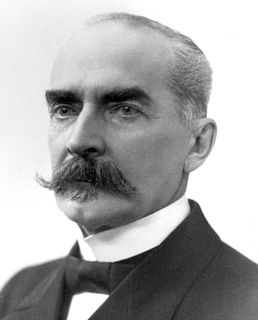
Indirect presidential elections were held for the first time in Finland in 1919. Although the country had declared Prince Frederick Charles of Hesse King on 9 October 1918, he renounced the throne on 14 December. The President was elected by Parliament, with Kaarlo Juho Ståhlberg of the National Progressive Party receiving 71.5% of the 200 votes. Ståhlberg, a moderate, liberal and reformist politician, who favoured improving the material well-being of workers and other economically poor Finns, received the votes of Social Democrats, Agrarians and Progressives. He also firmly supported the new Finnish Republic, and a parliamentary form of government with a strong President as a mediator and a political reserve for politically troubled times. Mannerheim, an independent right-winger and monarchist, suspected the democratic, republican and parliamentary form of government of producing too partisan political leaders, and of working ineffectively during crises. Ståhlberg favoured the signing of peace treaty between Finland and the Soviet Russia, while Mannerheim in the summer of 1919 strongly considered ordering the Finnish army to invade St. Petersburg to help the Russian Whites in that country's civil war. Only the National Coalitioners and Swedish People's Party voted for Mannerheim in this presidential election.
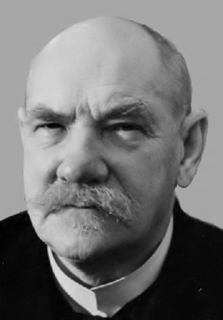
Two-stage presidential elections were held in Finland in 1931. On 15 and 16 January the public elected presidential electors to an electoral college. They in turn elected the President. The result was a victory for Pehr Evind Svinhufvud, who won on the third ballot by just two votes. The turnout for the popular vote was 47.3%. This presidential election was held during an ideologically, politically, socially and economically tense time. The Great Depression was impoverishing many Finnish farmers and workers. The far-right Lapua Movement had not settled for the ban of the Communist Party and its affiliated organizations in the autumn of 1930. It wanted to help elect a President who would also strongly oppose the Social Democrats and moderate bourgeois parties, such as the Progressives. Although Svinhufvud disapproved of the Lapua Movement's violent kidnappings of left-wing politicians and other illegal acts, he was their preferred presidential candidate. Former President K.J. Ståhlberg, a champion of democracy, parliamentarism and the rule of law, had been briefly kidnapped by some activists of the Lapua Movement with his wife in October 1930. He was chosen as the Progressive presidential candidate. Speaker of the Finnish Parliament, Kyösti Kallio, held ideals similar to those of Ståhlberg, and he became the Agrarian presidential candidate. The outgoing President, Lauri Kristian Relander, had lost the Agrarian presidential candidacy to Kallio, because he did not condemn the Lapua Movement as strongly as Kallio did, and a sufficient number of Agrarians believed that Kallio could control the Lapua Movement's extremists more effectively than Relander. Right-wing Finns and some centrists, such as a prominent Agrarian parliamentarian, Juho Niukkanen, were concerned that Ståhlberg's re-election as the Finnish President would escalate political tensions in Finland. The Commander-in-Chief of the Civil Guards, Major General Lauri Malmberg, announced in the Finnish Parliament that he would not guarantee order among the Civil Guards, if Ståhlberg was elected President. Svinhufvud's razor-thin victory required Niukkanen's arm-twisting tactics, whereby he pressured all the Agrarian presidential electors to support Svinhufvud. This 69-year-old and slightly ailing conservative politician was considered by his supporters as a sufficiently bold, solid and patriotic man to re-unite the ideologically divided Finns. His pro-democracy supporters hoped that he could keep both right-wing extremists and left-wing extremists in check.

Two-stage presidential elections were held in Finland in 1968. On 15 and 16 January the public elected presidential electors to an electoral college. They in turn elected the President. The result was a victory for Urho Kekkonen, who won on the first ballot. The turnout for the popular vote was 70.2.
The following lists events that happened during 2000 in Finland.





